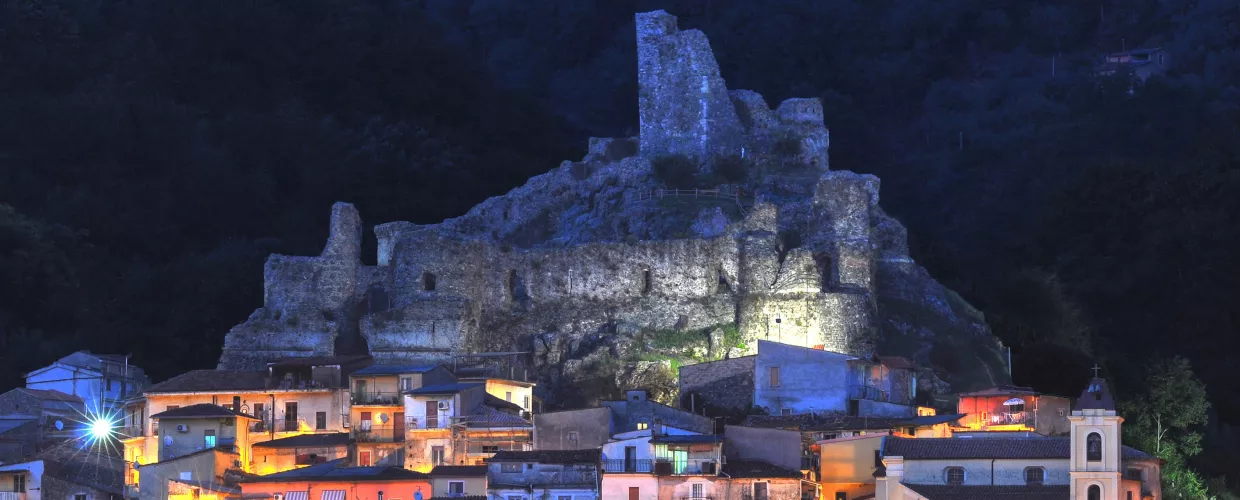This content was automatically translated. View the original text.

Overview
In Calabria, discover the beauty of Lamezia Terme
Lamezia Terme, the third largest city in Calabria by number of inhabitants, has a relatively recent history.
Established in 1968 from the merger of the municipalities of Nicastro, Sambiase and Sant'Eufemia, it is not only an important regional and national hub due to its strategic location in the centre of the region, but also a crucial business hub for the region's economy.
The Baths of Charon
Despite its modern origins, the name is much older: it derives from the first political community attested on this territory, the Lametìnoi, dating back to protohistoric times.
The Baths, on the other hand, refers to one of the main resources of the area, the Terme di Caronte, known since Roman times as Aque Angae. These four springs are located on the slopes of the Reventino mountain massif and, combined with the current of the Bagni river, give rise to different degrees of temperature: the highest reaches 39°C, hence the name Charon.
A plunge into the gurna
The facility is worth a visit if only for the beauty of its setting. It is located near the Gulf of Sant'Eufemia, surrounded by Mediterranean scrubland.
Among the many wellness facilities available is the gurna, a natural outdoor pool with free access all year round. Don't get too upset if you hear someone referring to this place in the plural: it is only because there used to be two pools. Here you can enjoy the benefits of the sulphurous waters and mud: the temperature reaches 40°C.
The secrets of ancient Terina
The first human settlements in what is now modern Lamezia Terme were discovered in 1865, when jewellery was found in the area of Sant'Eufemia Vetere, which was later sold to the British Museum in London, which still preserves it today.
This discovery, known as the Treasure of St Euphemia, was the first in a long series, which during the 20th century confirmed the ancient settlement of Terina. It was not until 1997, however, that it was decided to initiate a systematic search that identified a well-structured urban layout, of which we now know a living quarter built with parallel axes that define a regular urban grid. According to the most widely accepted hypothesis, this would be the extension of a pre-existing structure dating back to the 5th century BC.
Two rooms of the Lametino Archaeological Museum are dedicated to ancient Terina. Lametino Archaeological Museum housed in the Monumental Complex of San Domenico. Divided into three sections: Prehistoric, Classical and Medieval, will give you an insight into the history of this area, from the earliest times. There is, for instance, a hydria, which is a vase, dated between 380 and 370 BC, as well as everyday objects.
Dating back to 1550 is the Bastion of the Knights of Malta so called because it was assigned to the Knights of Malta who owned a fiefdom in nearby Sant'Eufemia del Golfo; an imposing defence tower capable of responding to enemy fire that is in perfect condition today.
The fairies of Nicastro Castle
There is still much to discover in Lamezia Terme, especially in the historic city centre. On Hill of San Teodoro, stands the Norman castle of Nicastro about whose origins there is some dispute. Built on the hillside, a unique strategic position to control the surrounding plain all the way to the sea, according to some dates back toByzantine era, according to others Svevo-Normana.
All that remains of the original structure are four towers, the ramparts, walls and a buttress with a small loggia; the earthquake of 1638 caused great damage to the structure, but at the same time contributed to the legends that populate it.
One of the most evocative is that of the fairy cave: when night falls, these creatures would leave their abode and wander through the ruins of the ancient manor house to the course of the Canne stream, to pick berries and flowers.
After seeing the castle, take a ten-minute stroll along Via SS Salvatore and Via Garibaldi towards the statue of Frederick II: on the king's right forearm rests a falcon that has just landed (he was responsible for the introduction of falconry in Italy, did you know that?) while looking towards the castle.
Not far from here, the Diocesan Museum preserves the history of the diocese from the 15th to the 20th century. The objects on display range from sacred vestments to reliquaries.
The House of Ancient Books, an immense heritage
During your walk through the historical centre of Lamezia Terme, you cannot miss the Casa del Libro Antico: it is located in Piazza Campanella and houses more than 2,500 volumes printed since the beginning of the 16th century. There are also Greek and Latin manuscripts. This is a truly important collection, which includes books on theology, philosophy, patrology, ecclesiastical history and exegesis, and consists mainly of book collections from the Capuchin and Dominican convents in Nicastro, but also from the library of the Friars Minor in Sambiase. Among the most important pieces in the collection are some ancient texts with notes in the margins by the philosopher Tommaso Campanella, who was born in the Calabrian town of Stilo.
The city's green lungs
There is also a lot of greenery in Lamezia Terme. The city is home to a Botanical Garden, established since 1972. There is a great variety of plants here, over a thousand species. More recent, however, is the S. Pietro Lametino Urban Park, a green lung of 15,000 square metres created in 2006. In the past it was a run-down area, today it is a different story. The redevelopment offers a beautiful place for citizens and visitors to relax.
88046 Lamezia Terme CZ, Italia